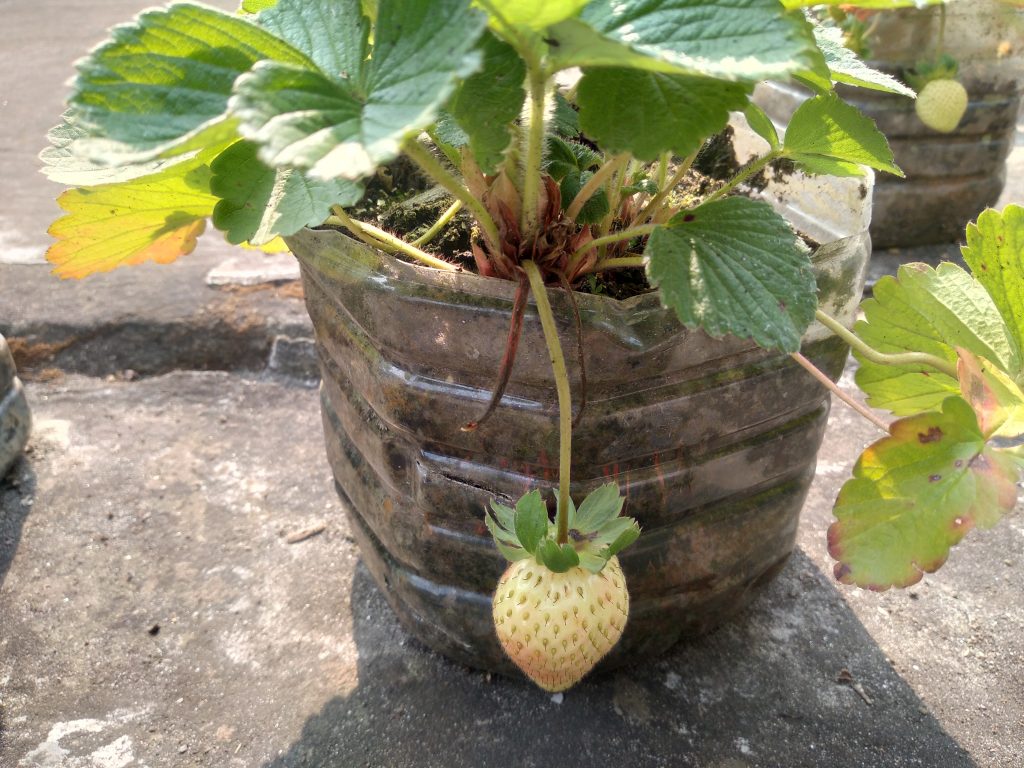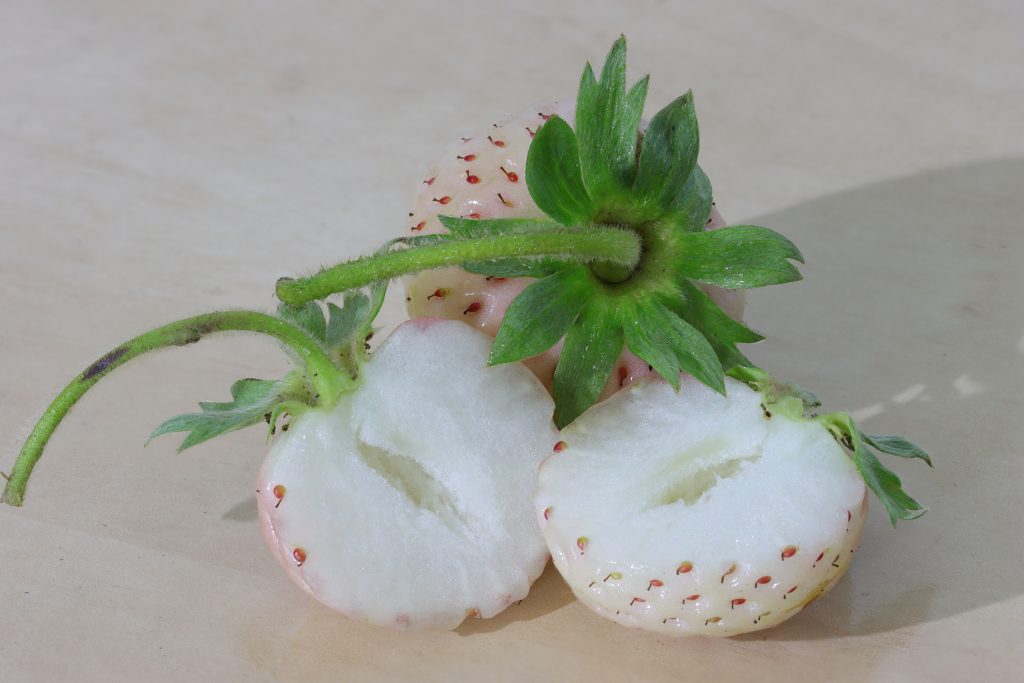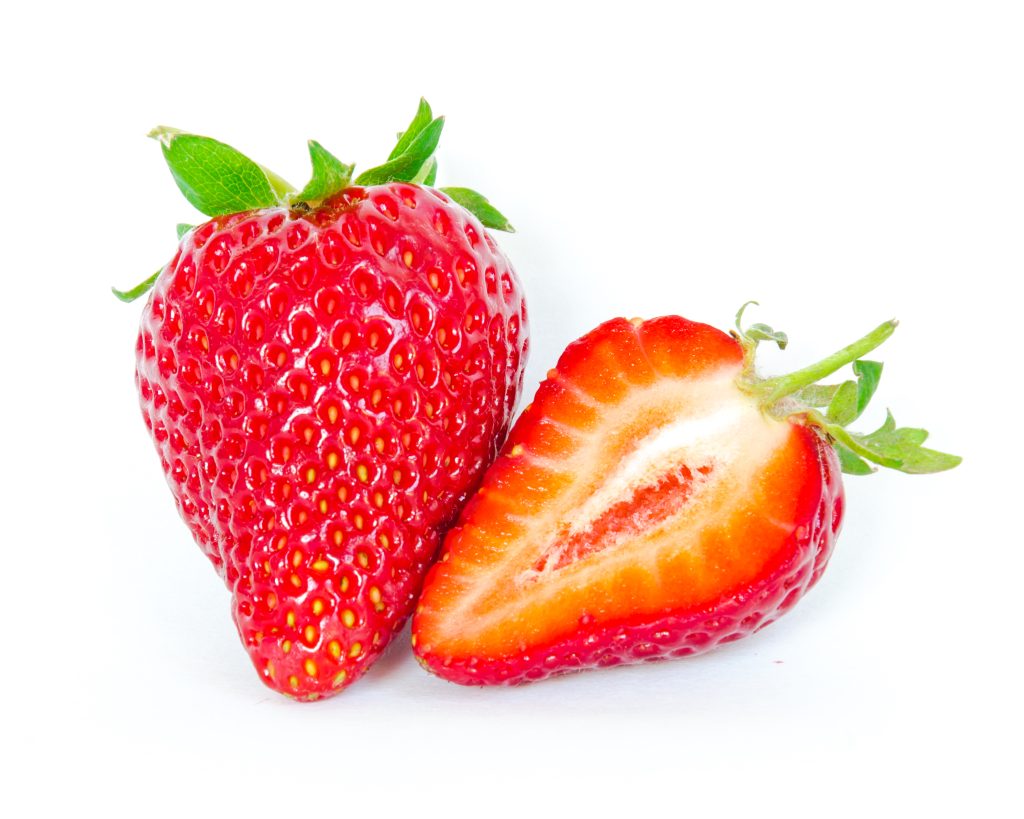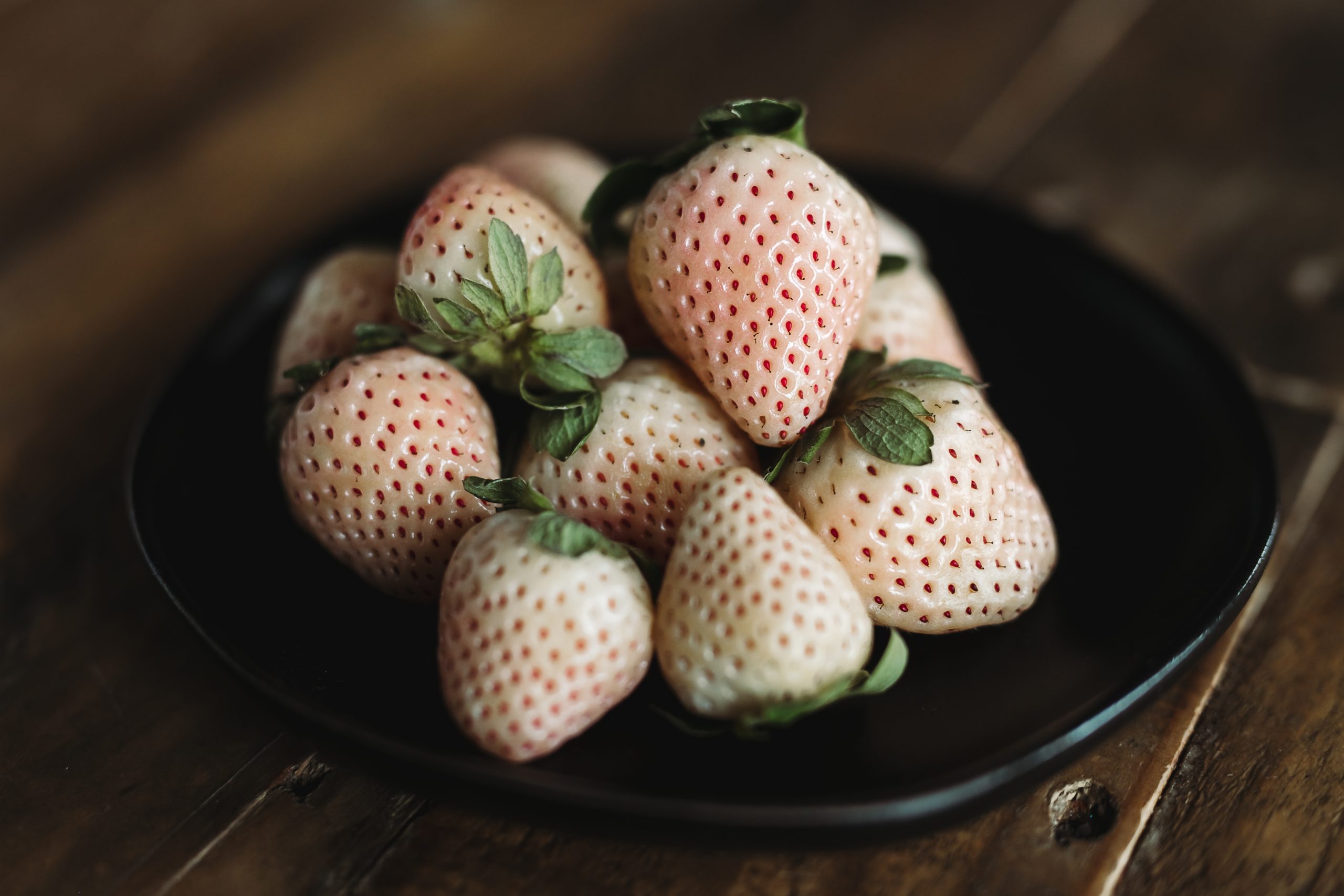Pineberries are a unique fruit that looks like a white strawberry but tastes like a cross between a pineapple and a strawberry. These berries are originally from South America and have been gaining popularity recently due to their distinct flavor and unusual appearance.
Table of Contents
What is a Pineberry?
A pineberry, also known as a “white strawberry” or “pineapple strawberry,” is a small, white fruit with red seeds that is similar in shape and size to a regular red strawberry (Fragaria ananassa).
It is not a hybrid of a pineapple and a strawberry, as some people believe, but rather a variety of strawberries bred to produce white fruit with a flavor just like pineapple. Actually, the pineberry is a cross between the wild South American strawberry (Fragaria chiloensis) and the North American strawberry (Fragaria virginiana).
Pineberries are believed to have originated in South America, but they have been cultivated in Europe since the 18th century. They are still relatively uncommon in the United States but can be found in specialty food stores and some farmers’ markets.
Pineberry plants have white flowers that appear during spring and will make fruit from late spring to early summer. You can also grow pineberries if you keep them in full sun and well-drained, moist soil, with enough spacing between each other.
The fruit is white, and the pineberry seeds are red (compared with regular strawberries that are red all around), giving it a unique appearance that sets it apart from other berries. Pineberries are also generally smaller than traditional strawberries and have a softer texture.
In terms of flavor, pineberries are known for their sweet and tangy taste, with a hint of pineapple flavor. They are often described as having a flavor similar to a cross between a pineapple and a strawberry, where they get their name.
Pineberries are split into June-bearing and everbearing types. Some varieties include the ‘White Pine,’ ‘White Carolina,’ and “Natural Albino’ white strawberry cultivars.

The History of Pineberries
As the story goes, Spanish explorers ventured into the mystical lands of Chile, where they encountered a delectable berry that they christened “chili.” These explorers and their trusty botanist companions were in awe of the fruit and named it chiloensis, paving the way for the legend of the pineberry.
As the eldest of all strawberries, the pineberry played a crucial role in the birth of the common strawberries we all know and love today. Hidden within Mananal, a mountainous sanctuary overlooking the ocean, the pineberries flourished in the wild and under the watchful eyes of organic cultivators.
With their unique association with Christmas and New Year festivities, these winter berries became prized at local markets and trade fairs. It was only a matter of time before their fame spread across the seas.
Thus the story of the pineberry reached the land of windmills and tulips, where Dutch horticulturists found inspiration in its origins. They embarked on a six-year quest to master the cultivation of this wondrous fruit, ultimately succeeding in introducing small-scale commercial crops in the Netherlands.
What Does a Pineberry Taste Like?
When eaten raw, a Pineberry has a sweet and tangy taste similar to a strawberry but with a hint of pineapple flavor. The taste can be slightly acidic and may have a tropical undertone. The texture resembles a strawberry with firm outer skin and soft, juicy flesh.
Pineberries are not commonly cooked but can be used in various recipes, such as jams, sauces, and desserts. When cooked, the flavor of the Pineberry is usually enhanced, becoming sweeter and more pronounced.
How to Tell When Pineberries Are Ripe
Here are some ways to tell when pineberries are ripe:
| Color | Ripe pineberries will have a pale pink or white color with a red seed exterior. The fruit is likely not fully ripe if it has a greenish tinge or is primarily red. |
| Texture | Pineberries should feel firm but slightly soft when pressed gently. Overly soft fruit may be overripe or starting to spoil. |
| Scent | Ripe pineberries have a sweet, fruity fragrance. The fruit may be overripe or spoiled if it smells sour or musty. |
| Smoothness/Roughness | The skin of pineberries should be smooth and without any cracks or bruises. |
Are Pineberries and Strawberries Related?


Pineberries and strawberries are closely related, as they belong to the Rosaceae family’s Fragaria genus. They are nearly identical genetically, but here are the key similarities and differences between the two fruits.
Similarities
| Genetic makeup | Pine and strawberries belong to the same genus, Fragaria, indicating their close genetic relationship. They share many common traits, including growth habits and fruit structure. |
| Appearance | Pineberries and strawberries have a similar structure, with achenes (the small, seed-like structures) on the surface of the fruit and a juicy, fleshy interior. Both fruits grow on low, ground-hugging plants with lobed green leaves and produce small white flowers. |
| Nutritional content | Pineberries and strawberries offer similar nutritional benefits, including high levels of vitamin C, antioxidants, and dietary fiber. |
Differences
| Color and appearance | The most noticeable difference between pineberries and strawberries is their color. Pineberries have a pale, white-to-creamy hue with bright red achenes, while strawberries are more commonly red with green or yellow achenes. This difference is due to varying levels of anthocyanins, which are pigments responsible for the red color in strawberries. |
| Flavor | Pineberries have a unique flavor profile that combines the taste of a strawberry with a hint of pineapple, giving them their name. On the other hand, strawberries have a more traditional berry flavor that can range from sweet to slightly tart, depending on the variety and ripeness. |
| Availability | Pineberries are less common than strawberries and can be harder to find. They are considered specialty fruit and may be available in limited quantities at select stores or farmers’ markets. Strawberries are widely available and grown in various regions around the world. |
| Cultivation | Pineberries are typically more delicate and require more specialized care during cultivation than strawberries. They may be more susceptible to diseases and pests. Strawberries are generally more robust and easier to grow on a larger scale. |
Cooking with Pineberries
Preparing Pineberries:
- Rinse the pineberries under cool water to remove any dirt or debris.
- Gently pat them dry with a paper towel or kitchen cloth.
- Remove the stem by pulling it gently from the top of the fruit.
Pineberries can be used in various ways, including as a garnish, in desserts, or in savory dishes. They are most commonly used in European cuisine, especially in Italy, Spain, and France.
Here are a few examples of dishes that use pineberries:
Pineberry Cloud Tart: This tart is as light and fluffy as a cloud but with the bonus of a sweet and tangy pineberry flavor.
Vegan Eton Mess: Who says you need eggs to make a meringue? This vegan Eton Mess recipe uses aquafaba, the liquid from a can of chickpeas, to create the perfect meringue texture. And with the addition of pink peppercorns and rose, your taste buds will be grateful.
Pineberry Muffins: With their delicate balance of sweet and tart flavors, and a fluffy muffin texture, you’ll be ready to conquer the day ahead. Plus, the pineberry adds a fun twist to a classic muffin recipe.
How to Store Pineberries
Pineberries are delicate fruit with a short shelf life. Here are some tips on how to store them:
Refrigerate: Pineberries should be stored in the refrigerator at a temperature of 32-36°F (0-2°C). Place them in a shallow container or on a paper towel to absorb any moisture. Pineberries can last up to 2-3 days in the refrigerator.
Freeze: Pineberries can also be frozen for more extended storage. Wash and pat dry the fruit, place them on a baking sheet, and freeze for 1-2 hours. Once frozen, transfer them to a freezer-safe container or bag and store them in the freezer for up to 6 months.
Dehydrate: Another option is to dehydrate pineberries. Wash and pat dry the fruit, then slice them in half and place them on a dehydrator tray. Dehydrate at 135°F (57°C) for 8-12 hours or until they are thoroughly dried. Store in an airtight container in a cool, dry place for up to 6 months.
Nutritional Benefits of Pineberries
Pineberries are a unique fruit that packs a powerful punch in terms of health benefits. First, they have plenty of fiber which can help with digestion issues.
These little berries are a great source of antioxidants that can help prevent heart disease, reduce blood pressure, and enhance the vascular system. Pineberries are also high in vitamins A and C, which can help support the body’s immune system and improve energy levels.
For pregnant women, pineberries are an excellent source of folate, a B vitamin essential for preventing congenital disabilities. Pineberries are also a great source of fiber, which can aid in weight management and promote healthy digestion.
To strengthen your bones and muscles, potassium and vitamin A found in pineberries can help promote healthy growth and support muscle contractions. Additionally, pineberries are rich in vitamin C, which can help prevent gout attacks and protect the body from iron deficiency.
Where to Purchase Pineberries
Pineberries are often available at stores specializing in exotic or rare produce. They might not be available year-round, so it’s best to call ahead to check their stock.
Local farmers’ markets are a great place to find pineberries. They are more likely to be available during the fruit’s peak season, typically April through June.
Several online retailers sell pineberries, often with the option to pre-order for delivery during the peak season.

